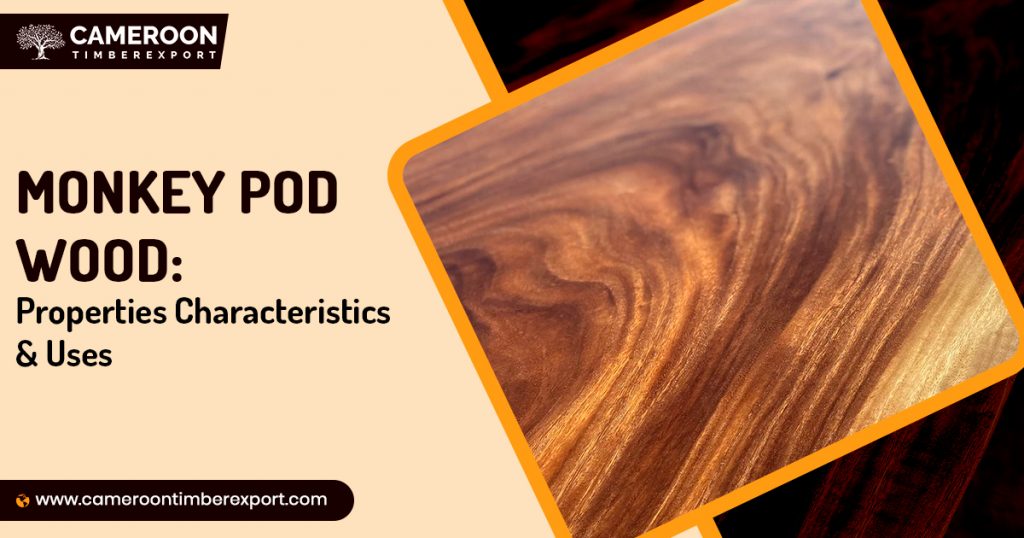Monkey Pod is a hardwood obtained from Monkey Pod Tree, which is also commonly called Raintree. It’s a hardwood with a 900 lbf Janka rating. The trees are naturally found in central and south America and are also planted in many tropical areas around the world.
Here’s everything you need to know about Monkey Pod wood, including its properties and applications.
What is Monkey Pod Wood?
Monkeypod is a hardwood. It is strong, durable and resistant to all kinds of decay, rot and insect attacks. The wood is considered suitable for a large variety of purposes because of its unique strength and appearance.
The scientific name of Monkeypod is Albizia saman wood. The raintree from which this wood is obtained primarily grows in central and south America but is also grown in tropical plantations around the world. The tree size is about 100-125 ft (height) with a 3-4 ft trunk diameter.
Monkeypod looks great in its natural color but is often finished or painted to get the desired appearance. It is naturally resistant and durable and is not required to be treated.
Properties of Monkey Pod Wood
Monkeypod heartwood has a naturally golden to dark brown color. The body may sometimes have dark streaks. Sapwood is light yellow or white and can be easily distinguished from heartwood. The wood is also often seen with curly grain patterns. Otherwise, the grain is normally straight, but the wavy or interlocked grain is not uncommon. The wood texture is medium to coarse.
The natural moderate luster and open large pores make the wood easy to identify. Because of its straight grain and significant hardness, the Monkeypod is rated as durable to very durable. It is resistant to rot, decay and most insect attacks. The wood can take its fair share of moisture and will not rot easily.
In terms of workability, Monkeypod wood is considered easy to work with because of its straight grain. The wood cuts easily and can be worked with both hand and machine tools. It also glues and finishes well.
Monkeypod is available in the form of logs, lumber and small wood pieces suitable for crafting. It is moderately priced for imported wood but is considered a cheaper alternative to Koa, which shares similar characteristics. Boards and lumber of Monkeypod wood can be sourced internationally from top timber merchants such as CameroonTimberExportSARL, which exports it to more than 20 countries across Asia, Europe, Australia, America and Africa.
Technical specifications of Monkeypod
Average Dried Weight: 38 lbs/ft3 (600 kg/m3)
Specific Gravity (Basic, 12% MC): .48, .60
Janka Hardness: 900 lbf (4,010 N)
Modulus of Rupture: 9,530 lbf/in2 (65.7 MPa)
Elastic Modulus: 1,149,000 lbf/in2 (7.92 GPa)
Crushing Strength: 5,790 lbf/in2 (39.9 MPa)
Shrinkage: Radial: 2.0%, Tangential: 3.4%, Volumetric: 6.0%, T/R Ratio: 1.7
Applications & Uses of Monkeypod
Monkeypod is strong, very durable and resistant to moisture, rot and insects, which makes it suitable for both outdoor and indoor uses. Basically, it’s a versatile wood that can be used for practically everything.
Common applications of Monkeypod wood include plywood, furniture, musical instruments such as guitars, veneering, carving, flooring, millwork, cabinetry and specialty wood items.
Even for outdoor purposes, Monkeypod wood makes a great choice because it doesn’t absorb moisture easily and will easily last decades in furniture and other outdoor objects.
One of the best things about Monkey Pod wood is its sustainability. Because Monkeypod trees grow very fast and can be planted in tropical regions anywhere in the world, it is easily available worldwide. Because it’s a seed-bearing tree, the seeds are often widely spread by birds and rodents, making them grow all over the world.
If you are looking for the best place to buy Monkeypod wood, timber or boards or want to know more about this hardwood, feel free to contact us at info@cameroontimberexport.com to talk to one of our experts.

